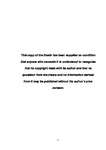Developmental timing in aquatic embryos: linking intraspecific heterochrony and evolution
| dc.contributor.supervisor | Rundle, Simon D | |
| dc.contributor.author | Tills, Oliver A | |
| dc.contributor.other | Faculty of Science and Engineering | en_US |
| dc.date.accessioned | 2013-02-21T16:46:35Z | |
| dc.date.available | 2013-02-21T16:46:35Z | |
| dc.date.issued | 2013 | |
| dc.identifier | 264819 | en_US |
| dc.identifier.uri | http://hdl.handle.net/10026.1/1402 | |
| dc.description | Full version unavailable due to 3rd party copyright restrictions. | |
| dc.description.abstract |
The main aim of this thesis is to understand the extent to which intraspecific variation in developmental event timing might provide the raw material from which heterochronies may originate. To this end I studied the timing of a suite of both morphological and physiological events in the embryonic development of Radix balthica, a species of aquatic snail known to exhibit event timing variation during the embryonic period (Tills et al. 2010; Rundle et al. 2011) and that sits within an evolutionary clade, in which extensive heterochrony has been documented (Smirthwaite et al. 2007). I found that variation in embryonic developmental event timing within R. balthica is pervasive (Chapters 2 - 5) and distributed primarily at low (inter-individual and egg mass), rather than high (population) biological levels (Chapter 3). This variation also appears to have a genetic basis (Chapter 2) and to be heritable (Chapters 4 and 5). Examination of the development of function in the cardiovascular (CV) system in Chapter 5 also revealed extensive variation, including differences between egg masses in the timing of aspects of this development, and differences between populations in the rates of change in heart rate during different phases of ontogeny. Variation in CV development also had effects on life history, which suggest that altered embryonic development might have implications for Darwinian fitness (Chapter 5). This thesis demonstrates that intraspecific variation in developmental event timing represents a fundamental link between ontogeny and phylogeny and that study of altered timing at the inter-individual level provides the opportunity to address questions concerning its evolvability and implications. | en_US |
| dc.language.iso | en | en_US |
| dc.publisher | University of Plymouth | en_US |
| dc.subject | heterochrony | en_US |
| dc.subject | intraspecific variation | en_US |
| dc.subject | developmental event timing | en_US |
| dc.title | Developmental timing in aquatic embryos: linking intraspecific heterochrony and evolution | en_US |
| dc.type | Thesis | |
| plymouth.version | Edited version | en_US |
| dc.identifier.doi | http://dx.doi.org/10.24382/3377 |
Files in this item
This item appears in the following Collection(s)
-
01 Research Theses Main Collection
Research Theses Main


